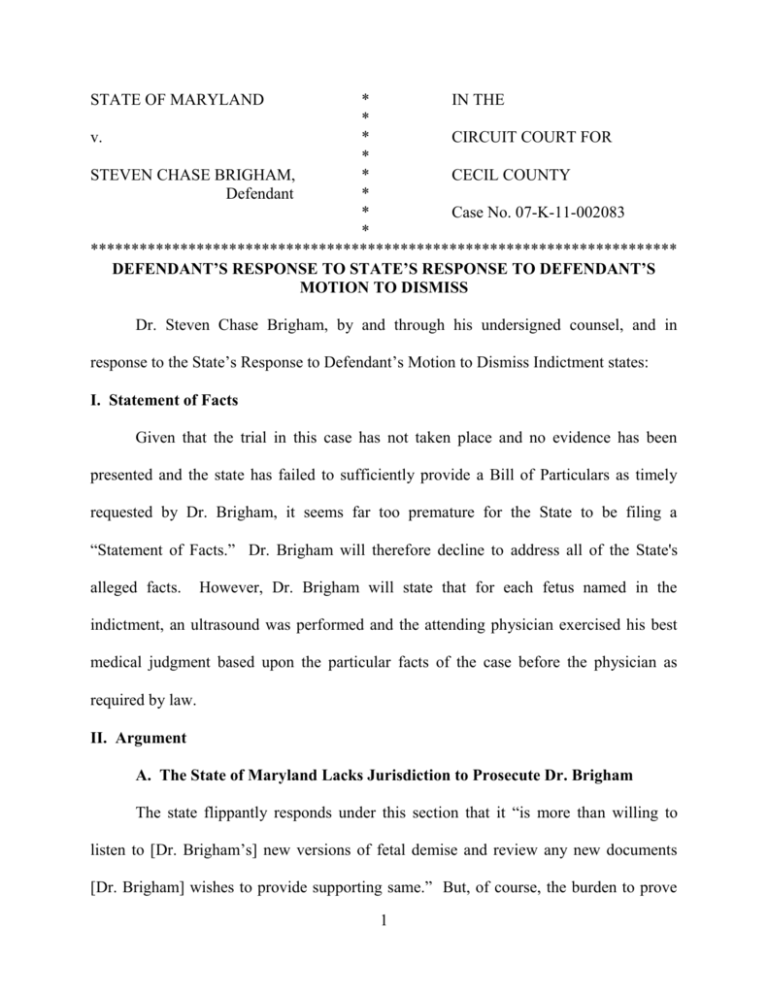prosecution unlawfully interferred with a woman`s right to choose an
advertisement

STATE OF MARYLAND * IN THE * v. * CIRCUIT COURT FOR * STEVEN CHASE BRIGHAM, * CECIL COUNTY Defendant * * Case No. 07-K-11-002083 * ************************************************************************ DEFENDANT’S RESPONSE TO STATE’S RESPONSE TO DEFENDANT’S MOTION TO DISMISS Dr. Steven Chase Brigham, by and through his undersigned counsel, and in response to the State’s Response to Defendant’s Motion to Dismiss Indictment states: I. Statement of Facts Given that the trial in this case has not taken place and no evidence has been presented and the state has failed to sufficiently provide a Bill of Particulars as timely requested by Dr. Brigham, it seems far too premature for the State to be filing a “Statement of Facts.” Dr. Brigham will therefore decline to address all of the State's alleged facts. However, Dr. Brigham will state that for each fetus named in the indictment, an ultrasound was performed and the attending physician exercised his best medical judgment based upon the particular facts of the case before the physician as required by law. II. Argument A. The State of Maryland Lacks Jurisdiction to Prosecute Dr. Brigham The state flippantly responds under this section that it “is more than willing to listen to [Dr. Brigham’s] new versions of fetal demise and review any new documents [Dr. Brigham] wishes to provide supporting same.” But, of course, the burden to prove 1 where the fetal demise actually occurred is on the State and not on Dr. Brigham. Moreover, the state’s failure to provide adequate discovery1 and to properly respond to Dr. Brigham’s request for a Bill of Particulars does leave one to guess as to precisely what is the basis for the State's prosecution of this case. B. Dr. Brigham Is Immune From Prosecution Pursuant to §2-103(e) The state does not contest Dr. Brigham’s assertion that §2-103(e) provides immunity to those physicians administering lawful medical care. (State’s Response at 8). Instead, the State relies upon their own assertion in the indictment that the fetuses were viable and therefore, they appear to allege, the medical care was not lawful. The definition of "viability" under CR §2-103 and HG §20-209 leaves the determination of viability solely to the attending physician and not to the State or the Medical Examiner. Whether the State or the medical examiner believes that, in their opinion, there was a "reasonable likelihood" of the fetus’s survival is simply irrelevant. The Medical Examiner has no knowledge of the "particular facts of the case" used by the attending physician to determine whether or not there is a "reasonable likelihood" of the fetus’s survival outside of the womb. If there is a disagreement between the Medical Examiner and the attending physician over whether or not the fetus was viable, the clear and Dr. Brigham has yet to receive any expert reports relied upon by the state to bring these charges. Additionally, it remains a mystery as to where the fetuses that are the subject of these charges actually are. Dr. Brigham has had no opportunity therefore to have his experts review this critical evidence. Nor has the State, as demanded in the Bill of Particulars, stated with specificity the facts the State relies upon to show that in reference to viability Dr. Brigham did not use his best medical judgment based upon the particular facts of each case. 1 2 unambiguous language of HG 20-209 (a) provides that the "judgment of the attending physician", by definition determines viability. The state takes issue, however, with Dr. Brigham’s recounting of the legislative history of §2-103. Specifically, the state “categorically denies [Dr. Brigham’s] statement that ‘[n]umerous documents in the bill file for House Bill 398 make it absolutely clear that it was never intended to penalize medical professionals who perform abortions.’” (State’s Response at 9). The state’s first complaint about this statement is that “[i]f this were true, [Dr. Brigham] would have submitted said documents with his motion.” (Id. ftnt. 7). Dr. Brigham did, in fact, attach “said documents” to his motion. The state simply chooses to ignore them as reflected in their responses as follows: “the state will decline to address most of [Dr. Brigham’s] arguments regarding legislative history in the underlying motion;” “[t]he state declines to address the February 17, 2005 and April 6, 2005 letters cited by [Dr. Brigham] from the Office of the Attorney General;” 2 and “the state declines to address all the bills cited by [Dr. Brigham] that were introduced The April 6, 2005 letter to Delegate Leo E. Green was in direct response to the delegate’s inquiry “whether this provision would provide immunity for the physician for injuries sustained by a woman as a result of malpractice in the performance of an abortion.” The response of the Office of the Attorney General was succinct and clear: “It is my view that the provision shelters physicians from criminal liability under the bill for lawful medical care, including lawful abortions, that result in the death of a fetus.” And, further, noting the provision of the bill which is now subsection (e) of 2-103, the Assistant Attorney General bluntly states “[i]t is my view that the main function of this provision is to protect the physician from criminal liability under the new section. Without such a provision, the plain language of the bill would allow prosecution of a physician who performs an abortion of a viable fetus for murder or manslaughter based on a lawful abortion, since the physician intends to cause the death of athe viable fetus.” (emphasis added). As for the February 17, 2005 letter to Delegate Charles Boutin, the Assistant Attorney General flatly states, “[i]t expressly does not subject a physician to prosecution for a decision to perform an abortion under that section.” (emphasis added). 2 3 subsequent to the passing of House Bill 398, as they do not address the legislative intent of MD CR §2-103.”3 (State’s Response at 8, 9 and 10). For the state’s edification, Dr. Brigham attaches to this response further documents clearly reflecting the legislative intention that §2-103 was never meant to apply to physicians performing abortions. These include: a letter dated February 17, 2005 from Anthony McCann, Secretary of the Department of Health and Mental Hygiene to Chairman Joseph Vallario discussing House Bill 398 and noting “[o]ther similar State and federal bills have exempted the pregnant woman as well as healthcare providers. The Department believes that without similar, specific clarifications HB 398 might result in serious criminal penalties being imposed upon mothers or healthcare providers for whom such harsh penalties may not be appropriate;” the Floor Amendments for House Bill 398 dated March 25, 2005, addressing the concerns expressed by Secretary McCann, and reflecting as “amendment no. 2” that it “provides … that the bill does not subject a physician or other licensed medical professional to liability for fetal death that occurs in the course of administering lawful medical care; that the bill does not apply to acts of the pregnant woman with regard to her own fetus…” and summarizes the bill by noting that It “may not be construed to confer personhood or any rights upon the fetus;” and finally the Floor Report 3 Of course, the state is flatly wrong in its assertion that bills passed after the enactment of §2103 have no bearing in determining the legislative intent in enacting the statute. Kaczorowski v. Mayor and City Council of Baltimore, 309 Md. 505, 514-15, 525 A.2d 628 (1987) (“When we pursue the context of statutory language, we are not limited to the words of the statute as they are printed in the Annotated Code. We may and often must consider other “external manifestations” or “persuasive evidence,” including a bill's title and function paragraphs, amendments that occurred as it passed through the legislature, its relationship to earlier and subsequent legislation, and other material that fairly bears on the fundamental issue of legislative purpose or goal, which becomes the context within which we read the particular language before us in a given case.”). 4 for House Bill 398 providing a “favorable” recommendation by the Senate Judicial Proceedings Committee and noting that “[t]he bill does not apply to a woman’s right to terminate a pregnancy, does not subject a physician or other licensed medical professional to liability for fetal death that occurs in the course of administering lawful medical care…and may not be construed to confer personhood or any rights upon the fetus.” (Exhibit 1). Second, the state takes issue with Dr. Brigham’s claim that the impetus for what is now §2-103 was the federal “Unborn Victims of Violence Act of 2004” which sought to “[e]stablish criminal penalties for inflicting bodily injury or death on a human fetus during the commission of a federal crime of violence against a pregnant woman.” As Dr. Brigham argued, §2-103 is directed at “punishing those who engage in acts of violence against a pregnant woman with the intent to cause the death of her viable fetus.” The State asserts that the Maryland law was not limited to fetal homicide resulting from crimes against pregnant women. Citing House Bill 520 introduced by Delegate Charles Boutin, the State asserts that “House Bill 520 was not intended to be limited to fetal death that occurred as a result of certain ‘felonies against pregnant woman’ [sic].” (State’s Response at 8). Dr. Brigham’s response to this argument, with all due respect, is so what? House Bill 520, as noted by the State in a footnote, never passed. But, in any event, the State is simply wrong. Research of the legislative history behind House Bill 520 also clearly demonstrates that it was meant to track the purpose of the federal law which was to provide for separate punishment for the death of a viable fetus resulting from a crime against a pregnant woman. For example, the “Legislative Wrap-Up” 5 prepared by the Department of Legislative Services, Issue 04-14 of April 2004 states that House Bill 520 “would have allowed a charge of a crime against a fetus, if certain crimes against a pregnant woman resulted in the harm or death of her fetus.” (emphasis added). Furthermore, the “90 Day Report” prepared by the Department of Legislative Services regarding the 2004 Session notes the following: Unborn Victims of Crime On April 1, 2004, President Bush signed legislation that makes it a separate offense to harm an “unborn child” while committing a violent federal crime against a pregnant woman. Under the Unborn Victims of Violence Act, violence against a pregnant woman is considered two separate crimes, regardless of whether an assailant is aware of the pregnancy. It covers embryos and fetuses from conception. Several unsuccessful bills were introduced on this subject during the session. The bills that drew the most attention were Senate Bill 349/House Bill 802 (both failed). These bills would have provided that the laws relating to murder, attempted murder, voluntary or involuntary manslaughter, and other specified offenses apply to circumstances where the victim is “an unborn child.” These provisions would not have applied to acts committed by the mother of the unborn child, acts committed during a legal abortion, or acts committed in accordance with specified medical practices. House Bill 520 (failed) would have allowed for the prosecution of murder, manslaughter, or unlawful homicide for an act or omission that occurred while the victim was a viable fetus. House Bill 1267 (failed) would have increased the maximum imprisonment penalties for a person convicted of second degree murder, manslaughter, and first and second degree assault when the person knew or had reason to know that the victim was pregnant. 6 (emphasis added). There is simply no support anywhere for the State’s argument that the current law was meant to criminalize abortions involving viable fetuses performed by a physician exercising his or her best medical judgment. D. Application of Md. Ann. Code, Criminal Law Article §2-103 to Abortion Procedures as Performed by Dr. Brigham Unconstitutionally Burdens a Woman’s Right to an Abortion and Unconstitutionally Interferes with a Doctor’s Good Faith Judgment as to Viability and the Necessity for the Procedure. Dr. Brigham has asserted two bases for why application of the fetal homicide law to the procedures he performed is unconstitutional as applied by the State. First, the State’s interpretation of §2-103 allows it to override a doctor’s determination that a fetus is not viable. As such, it chills the exercise of a woman’s constitutional right to an abortion of even nonviable fetuses which is clearly unconstitutional under Roe v. Wade, 410 U.S. 113 (1973). The State responds that “what is of critical importance regarding a doctor’s viability determination is not whether other doctors agree with his viability decision, but rather whether he made said viability determination in good faith and in his best medical judgment in accordance with accepted standards of medical practice.” (State’s Response at 13; emphasis in original).4 The State continues, “if a doctor, in good faith and in his best medical judgment in accordance with accepted standards of medical practice, determines that a fetus [is] not viable, said doctor is not subject to a criminal penalty for a decision to perform an abortion of said fetus.” (State’s Response at 13). Contrary to the statute, here the State completely conflates the decision to perform an 4 This is clearly a concession by the state that what other doctors, medical examiners, or socalled ‘experts’ believe is the point of viability regarding the fetuses at issue in Dr. Brigham’s case is irrelevant. To this extent, Dr. Brigham wholeheartedly agrees. 7 abortion with the determination of viability. §20-209(a) alone governs the viability determination and defines it as “that stage when, in the best medical judgment of the attending physician based on the particular facts of the case before the physician, there is a reasonable likelihood of the fetus’s sustained survival outside the womb.” (emphasis added). This section is in no way limited by a requirement that the determination of viability be made “in … accordance with accepted standards of medical practice.” That is language taken from subsection (d) which governs the physician’s decision whether or not to perform an abortion. Thus, the plain language of the statute leaves the determination of viability solely to the determination of the attending physician based on the peculiar facts before him or her. It is not subject to “accepted standards of medical practice;” and for good reason. As noted in his original motion, “medical judgment” must “embody the judicial need to tolerate responsible differences of medical opinion…” Stenberg v. Carhart, 530 U.S. 914, 937 (2000).5 That other doctors or experts may believe that a fetus is viable or has a reasonable likelihood of sustained survival outside the womb is irrelevant precisely because there can never be a universally and well defined standard of “reasonable likelihood.” Every determination is different because every patient is different. Were it otherwise, then the statute becomes void for vagueness and is constitutionally infirm for that reason.6 No attending physician would know if his It bears noting that the state, in its response, has apparently once again chosen to “decline to address” an argument made by Dr. Brigham. Dr. Brigham cites and relies upon the Stenberg case in making his constitutional arguments yet, the state ignores it completely. 5 It would also fail under a due process analysis because the physician could never be on notice of when his determination will result in criminal charges. 6 8 viability determination will subject him to criminal penalties under such a vague standard. CONCLUSION For the reasons presented, Dr. Brigham respectfully requests that the charges against him be dismissed. Respectfully Submitted Nancy S. Forster Law Office of Nancy S. Forster 925 Metfield Road Towson, Maryland 21286 443-790-1741 forster@nancyforsterlaw.com C. Thomas Brown Attorney at Law 205 East Main Street Elkton, Maryland 21921 410-398-3850 Attorneys for Steven Brigham CERTIFICATE OF SERVICE I HEREBY CERTIFY that on this ___ day of February, 2012, a copy of the foregoing Motion to Dismiss Indictment and Memorandum in Support of Motion to Dismiss Indictment was mailed to: Ellis Rollins III, State’s Attorney for Cecil County, Courthouse, 129 E. Main Street, Elkton, Maryland 21921. _____________________ 9 Nancy S. Forster STATE OF MARYLAND * IN THE * v. * CIRCUIT COURT FOR * STEVEN CHASE BRIGHAM, * CECIL COUNTY Defendant * * Case No. 07-K-11-002-083 * ************************************************************************ ORDER Upon consideration of the foregoing Motion to Dismiss Indictment and Memorandum of Law in Support of Motion to Dismiss Indictment, it is on this ___ day of _________, 2012, hereby ORDERED that the eleven count Indictment against Dr. Steven Chase Brigham be dismissed. _______________________ Judge 10 11


